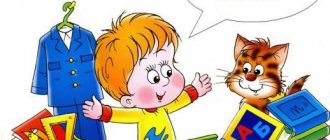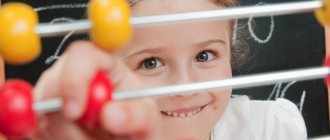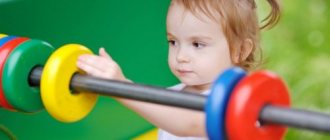Child development is a consistent and time-consuming task for parents. Intellectual and psychological development in children occurs very quickly, and the desire to learn new things is limitless. Therefore, amazing results can be achieved in the education of children. However, the question of how to learn numbers with a child is still difficult for parents. We subconsciously put off studying because we ourselves don’t like to count. But memorizing numbers should be a fun and exciting process for a child. The correct technique will help arouse the child’s interest and increase the effectiveness of learning. To do this, it is important to find out why it is difficult for children to remember numbers? They often seem similar to each other to preschoolers. Another reason may be that the child does not understand the information being studied. Therefore, you need to teach numbers to a preschooler gradually, without pressure. You shouldn’t study several numbers at once; it’s better to start one at a time. Learning numbers is not difficult, since memorizing numbers occurs during play using colorful pictures, bright visual images, and favorite toys.
Study plan
A preschooler can successfully learn letters and numbers. But for now, for him, these are just icons and incomprehensible hooks. The main thing is that parents’ interest in the result, their conscious desire and abilities turn mathematics lessons into an exciting journey into the world of knowledge. So how can you learn numbers with your child quickly and easily? To help you solve this problem, we suggest following a number learning plan:
- Encourage your baby to put away the right amount of toys or other items. The selected items must be placed in a row to make it easier for the child to count them.
- Explain to your child which number corresponds to the number of objects.
- Study the number with your child. Talk and find out what each number looks like. If in the future it will be difficult for a preschooler to immediately name a number, he will be able to remember it by association. Many people have very developed associative thinking. This fact formed the basis of mnemonics - the science of quick memorization.
- Do the exercise several times. This method will help you understand the relationship between a number and the number that represents it. The exercise develops several types of memory: visual, motor, muscle.
- In the future, talk to your child about this and other numbers until he can confidently name them.
- Draw the numbers together, sculpt them from plasticine and name them at every opportunity. They will become friends for the baby, and then he will remember them.
You need to accustom your child to numbers little by little when he is interested in them. There is no point in studying them earlier. Rushing through learning can ruin a child's interest in math. Study space also plays an important role. There should be no tablets, cartoons or distractions nearby. This will help the child focus on learning new material. Don't forget about good lighting, satisfied appetite and small bonuses for success.
What to do if your child cannot remember numbers? How to help?
Our Masha is smart. Very smart and talented and... Well, you get the idea.
But I couldn’t remember the numbers! No matter how much they repeated it, or counted it, they stuck the stickers on - no use.
All the numbers for Masha were the same.
Stop!
"On one face"
Here it is! This turned out to be the main secret of Masha and many other children.
It's all about perception! It varies from person to person. Not only for children, by the way.
There are children for whom a one is a one, and a two is a two. Well, you know, like a donkey is a donkey, and a lamb is a lamb. You'd probably be surprised if your child couldn't tell the difference between a donkey and a ram, right?
And there are children for whom one, two, three and everything, everything, everything (as well as letters!) -
JUST FOR - KO - RYU - CHKI!
And now imagine. They give you a sheet of squiggles and say:
- This squiggle is called “one”, this one is “two”, and this one is actually the letter “a”! Do you remember everything? Repeat!
Introduced? Scary? That’s how it is for children who can’t remember numbers and letters.
Well, okay, there’s nothing scary about it now, because we’ve already come up with a solution that helped us learn first the letters and then the numbers.
Our “ABC of Little Poets” will help you learn the letters, and today we will tell you about
Educational games
We all intuitively know how to learn numbers with a child quickly and easily: the main activity for children is play.
With its help, preschoolers master new information and consolidate it. Math games will help children become familiar with quantity, numbers and learn to count. They also help develop speech, attention, memory, and thinking. Activities with your child need to be made more difficult gradually. During the learning process, you should remain calm, even if the child does not immediately remember the numbers. We recommend praising your child for all small successes and victories. This will help maintain interest in learning. To study numbers, you can choose a fun game activity that is appropriate for the child’s age. How to teach a child numbers?
Here are educational games for children with numbers:
- “Match the number with the picture.” In the figure you need to find a number that corresponds to the number of objects. You can print or draw such drawings for free, you don’t even have to buy them.
- "Draw the numbers." Parents can read the description of the number, and the baby must guess what number we are talking about and draw it.
- "Funny numbers." The child tries to recognize numbers in interesting drawings, where the number is disguised with a funny plot. Here mom can be creative and draw her own drawings.
- "Talking Numbers" Choose or come up with several descriptions of numbers so that the child can guess what we are talking about. For example: the traffic light will tell you what number I have. Or “bad grade for students.”
- "The same number". For example, you can take cups and corresponding saucers (you can deliberately skip one so that the baby can correct you). Ask your child to find a pair for each circle and count the number of pairs.
- “Draw the numbers on the back.” The parent draws a number on the child's back. The baby's task is to guess. Then you can change places.
- "Find the missing number." Write the numbers from 1 to 10. Deliberately leave one out. The child must determine the missing number. This game exercise is great for training attention.
- "Confusion". During the game, we consolidate our knowledge of numbers, counting from 0 to 10 in forward and reverse order, and also develop attention and memory. We put the numbers in order, then the baby turns away, and the adult mixes them up. The child’s task is to understand and correct the mistake.
In the world around you, you and your child can count everything you see. For example, birds, cars, children, cats and dogs. With a little imagination, learning to count will turn into an exciting activity for your child. Systematic repetition of game exercises will help your child quickly learn to count and memorize numbers. It is important to celebrate his successes and rejoice in victories, even if they are not very significant yet. By the way, at the same time you can do another important thing - learning the alphabet.
Mathematics for children 2–3 years old. Learning numbers and learning to count
Maria Khvorostova
Mathematics for children 2–3 years old. Learning numbers and learning to count
MATHEMATICS FOR CHILDREN 2-3 YEARS OLD. LEARNING NUMBERS AND LEARNING TO COUNT
Kids very actively explore the world around them and absorb new knowledge like a sponge. It is important to feed this attraction, but not to overload the child. The age of 2-3 years is the time to consolidate knowledge and get acquainted with colors, shapes and quantities. The task of parents is to help the child learn to understand numbers and represent them clearly. For example, what is “five pears”, is it more or less than three, etc. We have prepared interesting games for counting, comparison, and also for the relationship between numbers and objects. Open your child to the fascinating world of mathematics. Mathematics for children. Where to start learning numbers From the age of two, children's thinking develops at a rapid pace. Now is the time to introduce your child to simple math concepts and counting. Kids already know many geometric shapes and have an idea of shape and size. Educational games and exercises will help you become familiar with numbers and numbers.
If you study regularly, then by the age of three you will be able to develop your first mathematical skills: the baby will learn to count consistently from one to five; will understand the difference between the concepts “one” and “many”; will learn what the words “more, less, equally” mean, will get used to comparing groups of objects; remember the graphic image of the first five numbers, be able to recognize them on cards and compare them with the quantity; recognizes the “+” and “” signs, learns to perform simple addition and subtraction examples.
Mathematical game “One Many” By the age of 2, children already know the word “many” and understand what it means. It's time to teach your child to compare different numbers of objects. As a result of the game, the child should form an idea of how “one” differs from “many”. Give your child a basket with five balls or marbles. Ask: “What is in the basket? (balls). How many balls? (a lot of). I'll take one ball. You also take one ball. How many balls do you have? (one). Let's give one ball to the bear and one to the duckling. How many balls are left in the basket? (one). How much was it at the beginning of the game? (a lot of). “There were a lot of balls in the basket, but there was only one left. Now we will collect all the balls in the basket. Put your ball there. Take another ball from me. Take the balls from the bear and the duckling." The kid collects balls. “There was one ball in the basket, but how many are there now?” (a lot of). To consolidate the mathematical concepts of “one” and “many” in children’s memory, use everyday situations more often: “How many apples are on the table - one or many? (one). What about nuts? (a lot of)". Use cards with images of one or several familiar objects: fruits, vegetables, geometric shapes. First, ask your child to find pictures with one object. Then change the task: you need to show cards with many objects drawn.
We learn to compare “More, less, equal.” We continue to introduce the child to mathematics. Next up are games and exercises with comparison of aggregates. By comparing the number of objects, the child learns to determine the difference: less, more or the same. Butterflies on daisies Draw a row of five large daisies on a piece of paper. Cut out 5 paper butterflies or use ready-made ones. Place your child at the table and start the game. “Chamomiles grew in the meadow. How many are there? Let's do the math. Well done, three. Beautiful butterflies have arrived. Count how many butterflies? That's right, four. Each butterfly sat on a daisy (put three butterflies on the flowers, and the fourth next to them). Look, one butterfly was missing a flower. Think about why this happened? What do we have more, butterflies or daisies? Well done, there are more butterflies - 4, and fewer flowers - 3 (show cards with numbers). Repeat after me. Look, one butterfly has flown away. How much is left? That's right, 3. And flowers? Also 3. Now there are as many daisies as butterflies. Another butterfly has flown away. What are there more now, flowers or butterflies? More flowers, well done. How many daisies? Three. And there are 2 butterflies, one less. What needs to be done so that there are equal numbers of flowers and butterflies? That’s right, remove one chamomile.” When naming numbers, show cards with the required numbers. As the game progresses, ask your baby to repeat new words: more, less, equally, the same.
Bunnies with carrots . The game reinforces counting and quantitative comparison skills. Intended for children 2.5-3 years old. Our task is to teach kids how to establish equality between groups of objects. You will need images of five identical hares and five carrots, and a sheet of paper. Draw 2 parallel lines one below the other. The distance between them should be sufficient to accommodate the figures. Ask your child to place 4 bunnies on the top line and 5 carrots on the bottom line. Make sure that the figures are located exactly one below the other. This makes it easier for the child to determine the difference in the number of objects. Ask your child what is more: hares or carrots? Offer to count. What can be done to ensure that there are equal numbers of both? That's right, remove 1 carrot. And if you don’t remove the carrots, how can you make it equal? That's right, plant another bunny. How many hares are there now? Five. What about carrots? Five. What more? That's right, they are equal. Such games and exercises teach the child to operate with the concepts of “more, less, equal.”
Exercises to consolidate counting up to 5 . Start learning by consistently counting within five. Remember that the goal of the classes is to get your child interested in mathematics. To maintain interest, we learn to count casually. Let’s ask the child to help in the kitchen: “We’ll have lunch soon. Who will sit at the table? Anya one, dad two, mom three, grandfather 4, grandmother 5. Repeat after me. Help mom, get 5 large spoons from the tray so that everyone has one spoon.” Young children willingly imitate their mother's actions. By helping around the house, kids simultaneously strengthen their mental arithmetic skills. Show your little one how to count fingers. Children love rhyming counters: “One, two, three, four, five, let’s count our fingers!” Practice counting every chance you get. Count toys, spoons, fruits, animals in a book, cars in the yard. Don't forget that math for 2-3 year olds should be fun. Little children love entertaining games: 1. The dog wants to go for a walk, but Masha is sleeping. The dog wakes up the girl, jumps and barks: woof-woof! How many times did the dog bark? Show me on your fingers. Repeat in several variations. 2. The kitten calls its mother. Take a soft toy and say “meow” 4 times. How many times has the kitten meowed? You need to show 4 fingers. Teach your child to show numbers in different ways. Explain that the number 5 can be shown on one palm or in another way: 3 fingers on the right hand, and 2 on the left. This is how the baby learns that numbers are broken down into their component parts. This will help you solve addition and subtraction examples in the future.
Games for the ratio of numbers and objects. It is convenient to introduce your baby to numbers while walking. Show and name the numbers of houses, cars, apartments. This way, the child will quickly remember the graphic image and the names of the numbers. The next task is more difficult. You have to figure out how many objects are hidden behind each number. Place in a prominent place a table or cards with large numbers, supplemented by images of familiar objects in the required quantity.
The pictures must be uniform, for example, squares. One square will be drawn next to the number 1, two next to the number two, and so on. Draw your baby's attention to these images more often. Gradually, the child will understand the connection between numbers and the number of objects. Additionally, educational games and exercises will help.
Numbers and cubes . Show your child a card with the number 1 and ask for one cube. Continue until number 3. The child needs to count and bring the required number of cubes. Show how to complete the task. If no difficulties arise, proceed to counting to 5. With the help of a simple exercise, the baby will learn to correlate the number of objects with a number. It is convenient to use magnetic numbers that are attached to the refrigerator or a special board.
"Lost" . You will need numbers from 1 to 5 on cards or made of thick material. The game is played on a children's rug. Arrange piles of any small objects in advance: pebbles, nuts, balls.
Explain to your child that the numbers are lost, cannot find their place, and need help. Instruct your child to find the pile corresponding to each number and put the “lost” next to it. Fun exercise. We've had a good workout, it's time to do some exercises. Mom shows cards with numbers and gives tasks: number 3 you need to jump 3 times, squat 2 times and so on, until number 5.
First examples. Learning to add and subtract The baby already knows how to count to 5, correctly recognizes numbers, and knows the concepts of “more”, “less”, “equally”. It's time to get acquainted with the first arithmetic operations: addition, subtraction, plus and minus signs. As before, we learn to count through the game.
To prepare your child for classes, introduce new words into everyday use: add, subtract, become more/less. Let’s say that while on a walk, a baby collects beautiful pebbles. Mom asks: “Show me, how many pebbles do you have? (3). I'll add one more, there will be more stones. How much did you get? (4). We put together 3 pebbles and 1 pebble. There are 4 in total. And if I take away 2 pebbles, how many will remain? (2). There are 2 fewer pebbles.” During classes, use 5 objects of the same type: nuts, candies, buttons or cubes. Prepare cards with numbers up to 5 and the signs “+” and “”. Mom tells the baby: “To learn to count like mom and dad, you need to know numbers and signs. We have already become familiar with the numbers. Today three main signs came to us. Their names are Plus, Minus and Equals." A truck pulls up, in the back there are cards with images of signs. “See how you can play with signs. Plus he likes to add everything up, he likes to add, to do more.” For your child to remember the name of the sign, read the rhyme: “Plus will help us play, add and add!” Place 2 cubes next to each other. Ask the baby: “How many cubes are there on the table? (2). Now I’ll put a Plus sign, and you add 1 more cube. Are there more or fewer cubes? (More). How much more? (On 1). Now let’s put the equal sign, it will show what we have done.” Place an “=” sign next to the last die. “How many cubes are there? (3)".
Children are introduced to subtraction in the same way. Use the rhyme “Minus loves to reduce, subtract and subtract!” If your child copes with tasks easily, make the task more difficult. Ask your child to show cards with numbers as they proceed. From this one step to classes with examples. As a result, the baby will learn that when adding, the number of objects increases, and when subtracting, it decreases.
Exercises
All parents know how difficult it is to teach a child numbers. To make learning easier, we recommend visualizing the information. There are several options on how to do this:
- Prepare large pictures with numbers. You can invite your child to paint it with bright colors;
- Another option is to depict the figures and the number of elements that correspond to the desired number;
- Look for familiar numbers for your baby in everyday life. On the street, in the store, at home.
- Ask your child to help you count the goods in the cart or the birds on the tree (“otherwise I can’t see”). This helps him understand why all this math is needed. In addition, he feels important and gets motivated to continue studying.
- Ask your child to take exactly three cookies from the pack and give you exactly two bananas. This will also be a great workout for your baby.
These useful habits will help you learn numbers with your child quickly and easily, which allow you to appreciate the significance of these activities.
How to teach a child numbers?
The sooner the learning process begins (especially in a home atmosphere), the easier it will be to achieve a positive result. The main thing is that it is interesting, entertaining and unobtrusive. It is not difficult to learn, since memorizing the number easily occurs during the game, using colorful pictures, vivid visual images, and favorite toys.
Classes
Often parents, when starting to teach their child mathematics, mainly pay attention to ordinal counting or memorizing numbers.
Learning quantities rather than numbers can help your child learn to count quickly. And also understand the meaning of the material studied. For a child, the concept of “five candies” should not be just words; the child needs to understand how much it is. So you need to figure out how to teach your child numbers and do it with specific examples? There are interesting tasks for children to learn numbers, here are some of them:
- Board games. Various games with cubes and counters are a well-known method for teaching ordinal counting with preschoolers. By regularly reading the symbols on the cube, the child remembers the number and understands the relationship with the number of objects. Taking a step in the game, he understands that it is not two or three steps.
- Personal information. Information about the preschooler himself can help him remember numbers. For example, you can associate numbers with the child’s age, apartment or house number. Everything that surrounds your baby will help you learn numbers. Let his relatives ask him where he lives? What is the apartment number? Correct answers will help your child get pleasant emotions and consolidate the acquired knowledge.
- Art Gallery. You can create an art gallery with your child. And the pictures will contain images of numbers. Let the child choose what he likes best.
There are several options for creating paintings:
- Representation of numbers with paints, pencils;
- Using plasticine and glitter;
- Cutting numbers from cardboard or paper;
- Application;
- Laying out numbers from available materials, such as pasta or beans.
When the child becomes familiar with the next figure and does the necessary exercises, it is worth consolidating the new information.
Together with your child, look for familiar numbers on various objects - on the pages of fairy tales, on advertising signs, in images in books, and so on. If it is difficult for a child to learn new material, you need to additionally do similar exercises with him. Now you know how to learn numbers with your child. But keep in mind that a difficult topic must be repeated after some time. Classes with children on teaching numbers should be carried out consistently and regularly. Information is studied from simple to complex. You should not move forward until the previous material has not been fully mastered. The previous material is the basis for studying new topics. Only regular lessons with children on teaching numbers will lead to success. And if things get hot, you can turn your attention to studying the multiplication tables.
Magic “Poem Counting” technique
0 – zero
There is not a single steering wheel!
So this is the number ZERO!
1 – one
Thin nosed gentleman
There is always ONE standing like a pillar!
2 – two
The swan barely swam to us,
Turned into number two!
3 – three
Rub two rings
And you get the number three!
4 – four
This is a hanger in the apartment!
And also the number four!
5 – five
If the tail is rounded,
You will immediately become number five!
6 – six
Is there a tail on top of the circle?!
So this is number six!
7 – seven
The pole is completely askew!
The result is number seven!
8 – eight
We'll ask for a tumbler
Become number eight today!
How to teach a child to write numbers?
It is worth teaching a child to write numbers after mastering mental counting. The child’s psychological attitude plays an important role in the learning process. It is impossible to avoid whims if the child does not want to study or does not understand the meaning of new information. You should also take into account the duration of classes, because a baby gets tired much faster than an adult. Psychologists do not recommend forcing a preschooler to complete a task until it succeeds. If the child is tired, you need to postpone the exercise for a while and switch to other activities. In order for your child to enjoy learning numbers, you need to interest him. Eliminate repetitive tasks. There are several teaching methods:
- Writing numbers by dots.
- Mathematical recipes.
- Counting sticks.
- Counting with objects.
- Application of the Montessori method.
Using various techniques will help your child maintain interest in learning numbers for a long time.
A variety of visual information and playful forms will help your child quickly master counting and recognize numbers. When studying numbers with a preschooler, you need to break them down into elements. The child will quickly understand and remember the algorithm for writing them. When teaching this technique to a preschooler, explain important points.
Your child needs the following skills to successfully learn to write numbers:
- A preschooler should easily navigate the notebook sheet.
- The baby must know the right and left sides, the upper and lower boundaries of the cage.
- The child understands where the boundaries of the cell are.
- Visually, you can divide the cell into four squares.
- Can write with slant.
When a child masters the listed skills, he will be able to perform more complex exercises - learn to write numbers. Here are some other important aspects for preparing your child for school, don’t miss them. Now the requirements for first-graders are very strict.
Teaching your child numbers: rules for success
Healthy interest
Getting to know the numbers should be interesting and bright. After all, as a rule, this happens at 3-4 years old, that is, at an age when children are not yet aware of what “need” is, obviously preferring the verb “want”. Therefore, learning must necessarily take place in a playful way, so that the child enjoys the process and is not forced into it. If the child takes on each lesson with enthusiasm, it means that he will grasp the material on the fly!
Selection of mathematical copybooks
It is best to use printed materials to teach your child how to write numbers correctly. You can print the math workbook yourself or purchase it at any bookstore. It is necessary to take into account that they come in different types and are designed for a certain age. You should not force materials on your child that are not appropriate for his age and level of training. He won’t become smarter, but he will definitely hate studying.
- At the age of 3-4 years, we recommend using copybooks with funny numbers. Fascinating illustrations can interest a child.
- At 4-5 years old, you can use didactic materials with figures. They will help train your child's hand.
- At the age of 5-7, we suggest that you use copybooks that contain an example of writing a number. For independent learning, a dotted outline is presented that the child can easily repeat. It is worth paying attention to didactic materials that contain additional tasks for hand training.
After the age of five, a preschooler begins to write numbers according to all the rules.
The child masters practical skills gradually. If you exclude any stage, working with copybooks will not be easy. Due to a lack of understanding of how to perform a particular exercise and poor finger coordination, a young student can be anxious and moody. The main task of parents is to be calm and not irritated if they need to return to the initial stage of learning. An easier task—reading—will help diversify your math classes and relieve stress. Find out how many words a child should be able to read in a minute in first grade. Classes should be conducted in a friendly and positive atmosphere. Imagine with your child and come up with interesting tasks. Then new knowledge will cause him only positive emotions, and the child will be able to feel confident at school!
Author: Rita Borzenkova
Step-by-step instructions for teaching your child to count
Adults think and perceive the world differently: some are better at working with images and objects, while others find it easier to navigate abstract mathematical categories. As for small children, everything is simpler: all of them, with rare exceptions, perceive the world through objects, and abstractions for the time being are beyond their understanding.
Therefore, in order to teach a child to count, it is necessary to operate either with the objects themselves or with their images. The first is preferable, since it is very important that the baby can not only see what he has to count, but also touch, smell and even, possibly, taste.
The reason lies precisely in the fact that he needs to link an abstract number with an object that is understandable to him, real and perceptible by all senses. These can be fruits, vegetables, candies, toys, and even your own fingers (in this case, of course, you shouldn’t try them on your teeth).
It is especially important to work with objects when you are dealing with very young children aged 1.5-2 years. Older guys are already excellent at using pictures.
"Dog and Cat"
You can start learning at about one and a half years old, but at this age, when the child still does not really know how to speak, you should not expect any outstanding results from him. Just introduce him to the concept of counting - lay out toys in front of him and say: “Here is one dog. But here is a dog and a cat” and so on. Give your baby a toy in each hand so that he subconsciously associates their number with the number of hands. In a word, prepare him for future training.
Count everything you see
From the age of three you can begin full-time education. And start with the simplest thing, with your fingers, because there are ten of them. From this age on, try to talk to your child about numbers as much as possible. These can be the simplest phrases: “We live on the third floor,” “We need bus number 15, and we get off at the fourth stop,” and so on. Ask your child to count all the objects he sees, as well as steps, steps and any actions he performs. At this stage of learning, it is already quite possible to work with pictures, so you can make special cards that will depict a different number of objects known to the baby: one apple, two plums, three berries. All kinds of counting poems are very useful at this stage - they are easy to remember, and counting is learned along with them.
In general, when starting to teach your child to count, remember two important things.
- Until about 5 years of age, a child cannot operate with abstract concepts, so counting must be tied to specific objects - real or drawn. For the same reason, do not try to immediately show your child writing numbers, at least until he begins to confidently count to 10 and solve simple addition and subtraction problems.
- Never scold your child for mistakes, but do not skimp on praise. Studying should evoke only positive emotions in him, and the approval of his parents gives him an incentive to study better.











